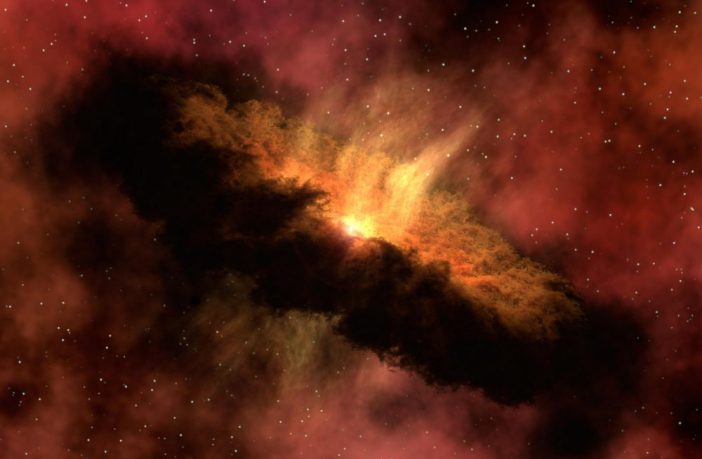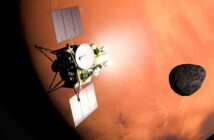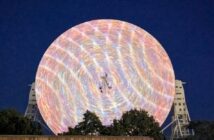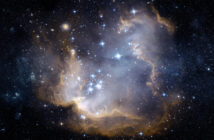Open University researchers have been investigating exactly how planet formation starts.
Why do we need to know how planets form?
Planets form as a by-product of star formation. Similar to asteroids, comets, and our Moon, planets are basically the left-over “junk” that isn’t incorporated into the star itself. However, planets (and other small bodies in a star-panet system) are also exciting places, where the conditions might just exist to have an atmopshere and liquid water, and the potential for the emergence of life.
Understanding planet formation is one of the big questions driving astrobiology, astrochemistry, and astronomy research.
What’s the current theory on how planets are formed?
Our basic understanding is that small icy particles stick together, building bigger particles which then also stick, and so forth, until eventually, we have a planet. However, as with any scientific endeavour, nothing is as simple as it seems and there isn’t a concrete answer to the question of how planets form.
We understand the forces that make very small things (smaller than the width of a human hair) stick; we understand that gravity makes big things stick, but in between scientists are flummoxed. Researchers at The Open University have been investigating the ‘stick and grow’ theory with a series of experiments, involving scientists from across Europe.
What was the experiment?
Dr Helen Fraser’s research team built a “particle-bashing” machine to test if icy grains collide and stick in space. To recreate a space-like microgravity environment, the experiment had to operate at low pressure, low temperature and very low velocity. You can take a look at the machine and listen to Dr Fraser explaining how it works in this video:
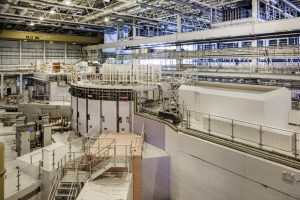
ISIS Neutron Source facility at the Rutherford Appleton Laboratory
In the experiment the particles did not stick together, but instead bounced off each other. The team found that the particles started slowing and rotating, which led them to a theory that there could be a ‘traffic jam’ of particles co-alessing together to form something larger (such theories have been suggested in planet formation, but this is the first empirical evidence we have.
Still, good scientific endeavor involves searching the problem from all angles. Could there be other explanations for why the particles didn’t stick?
The researchers then took a unique approach, and decided to test the behaviour, structure, and surface of the ice particles they were using. They took the particles to the world-leading ISIS Neutron source at the Rutherford Appleton Laboratory in Oxfordshire to find out more.
What did they discover about the icy particles?
The OU team found that at very low pressures and temperatures, the icy particles began to ‘melt’, creating a surface which would make sticking together much easier when they collided with other particles.
Good news for the ‘stick and grow’ theory?
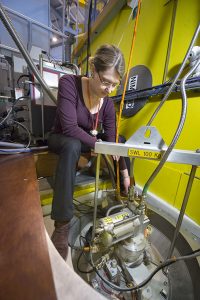
Dr Sabrina Gaertner, using the NIMROD instrument
The OU team found that, at very low pressures and temperatures, the icy particles really do very little, but when they raised the temperature just a little (and still to only minus 73 degrees centigrade) the surfaces of the icy partciles began to ‘melt’, not enough to make liquid water, but enough to mush the water molecules on the surface of one particle with those on another particle and, hey-presto, sticking occurs.
Yes, but bad news too, as the conditions under which the ‘melt’ occurred are also well outside those conditions found in space where planets form.
“The experiments have suggested that the ice surface structure is fundamental to whether icy particles stick or not,” said Dr Sabrina Gaertner, the postdoctoral researcher who led the paper. “The good news with what we have learned is that ice could act as a “glue” in planet building processes, but the tough news is that whilst the conditions most suited to ice-sticking are easy to obtain in the laboratory, they are unlikely to be found in space. In solving one mystery we have opened the door to many more questions – it’s still not clear exactly how planets form.”
Dr Fraser’s team will continue, with new grants from the UK Space Agency and the Science and Technology Funding Council, to investigate this further and take us closer to answering the question of how planets are formed.
Find out more
Read the full research paper, published in Astrophysical Journal, Micrometer-sized water ice particles for planetary science experiments: Influence of surface structure on collisional properties
Watch our 60 second Adventure in Microgravity on OpenLearn
Find out more about Research in the Astrochemistry Group
